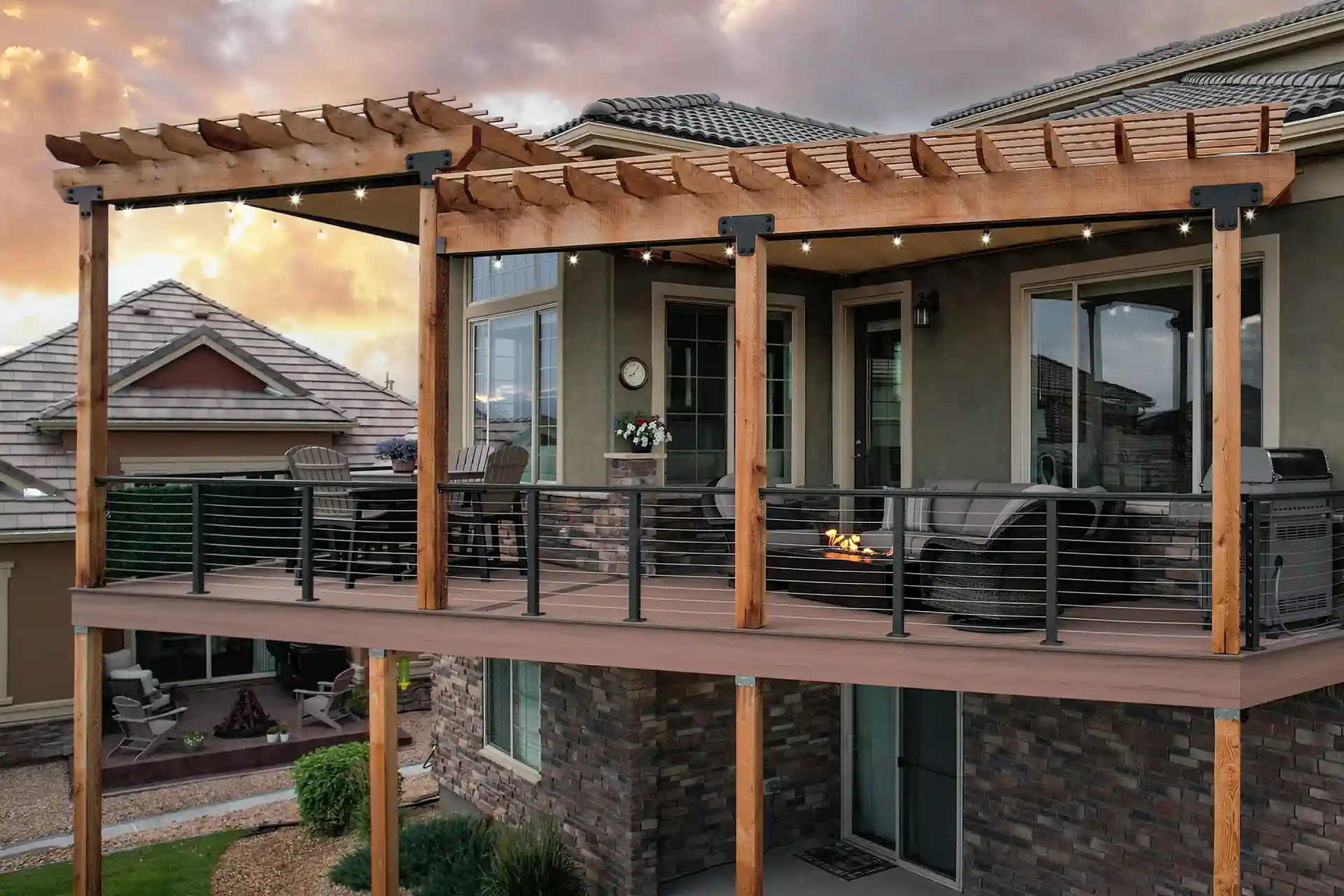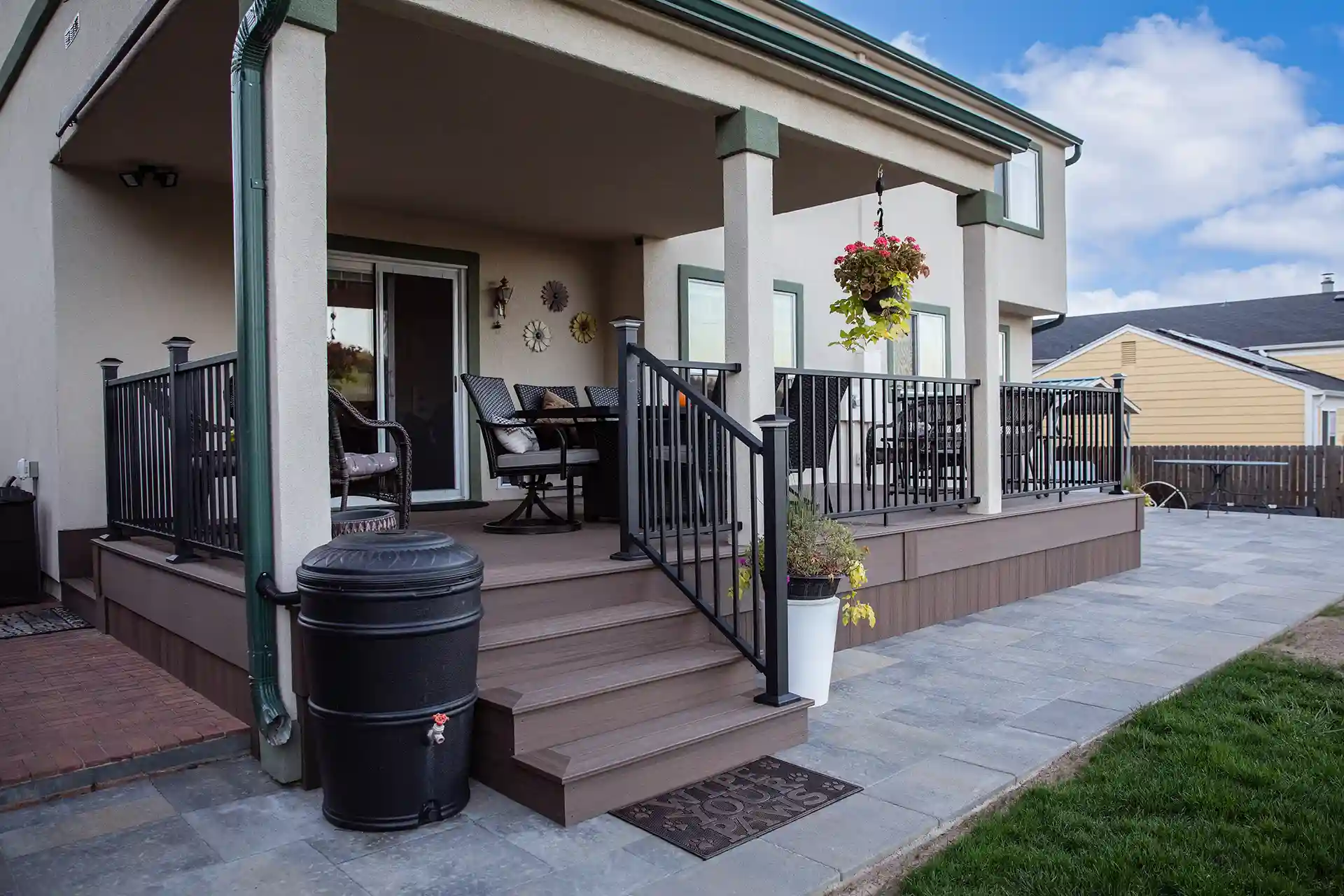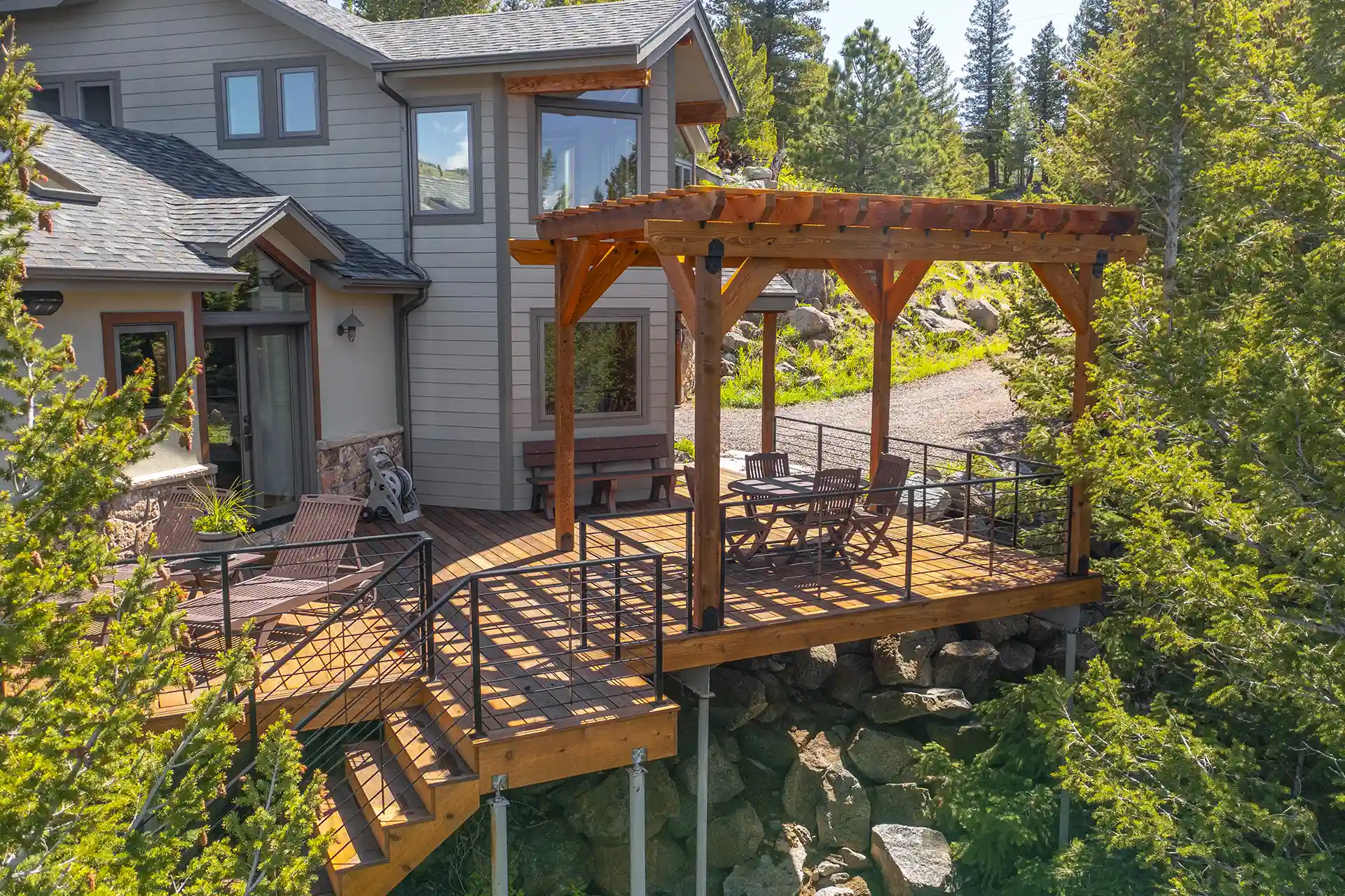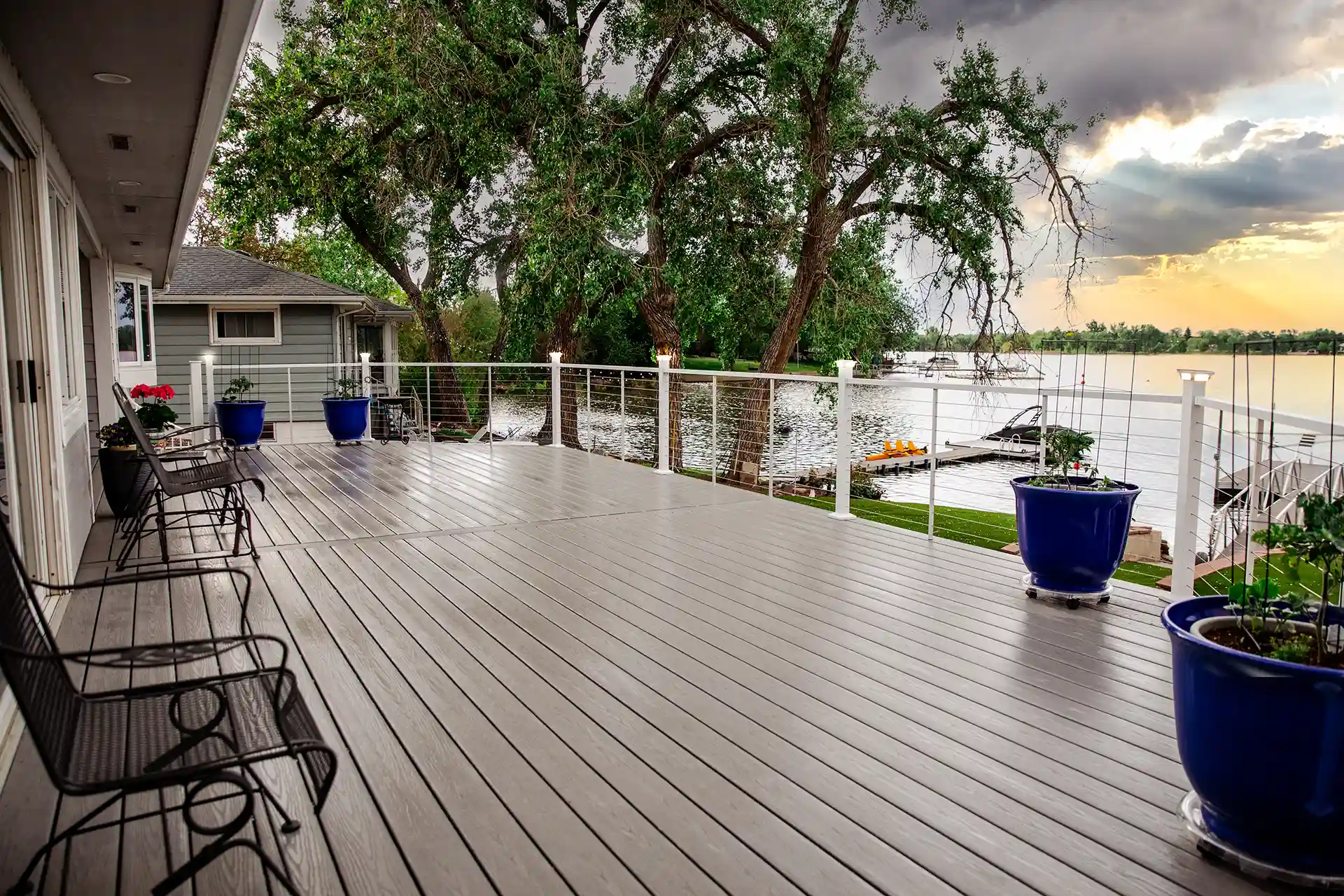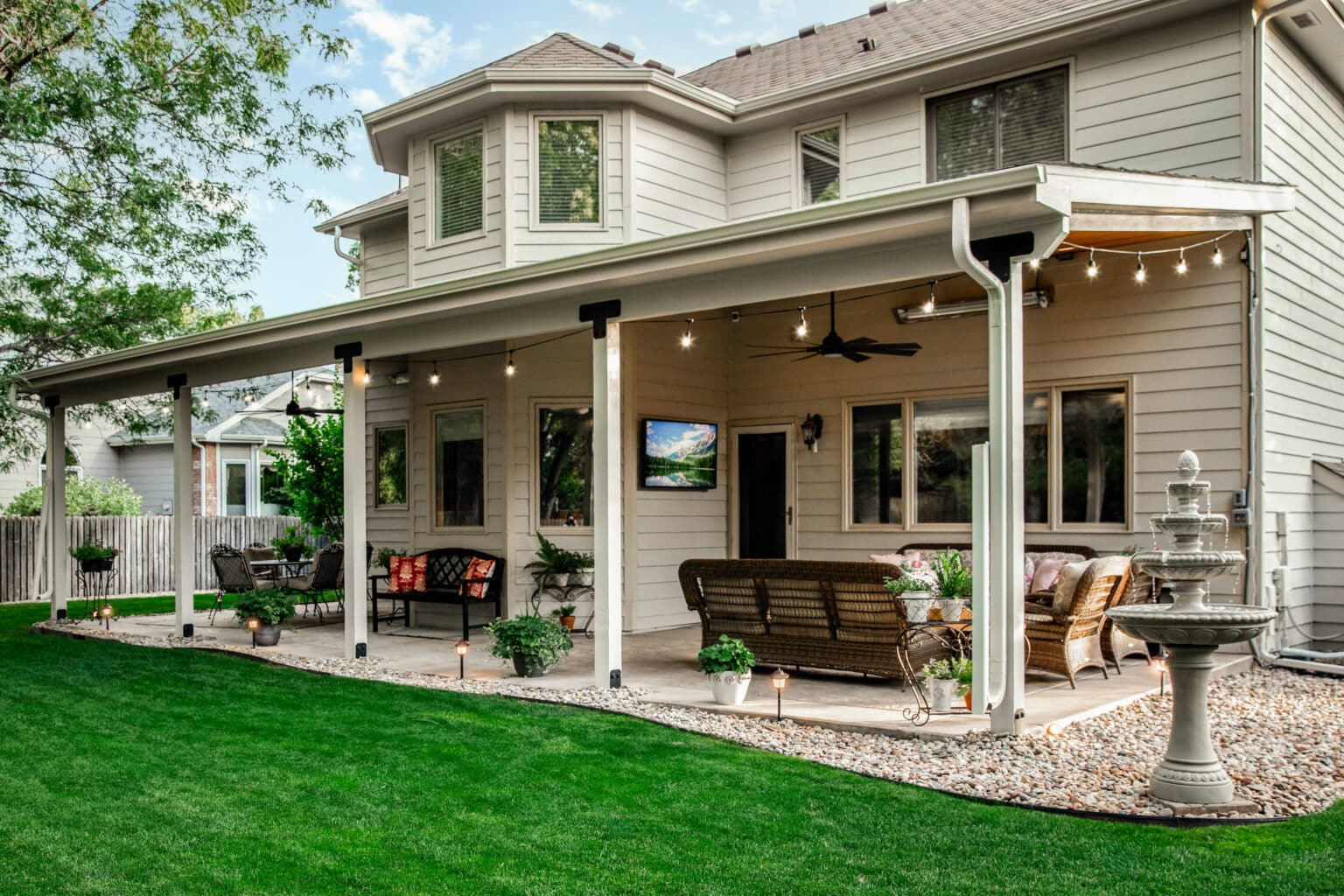Deck stair railings play a critical role in ensuring safety and complying with building codes in Broomfield, Colorado. When constructing or upgrading a deck, selecting the correct type of railing can significantly impact both the function and look of the stairs. With several material and design options available, it is important to select a railing system that meets specific safety requirements while complementing the overall design of your deck.
In this post, we’ll delve into various deck stair railing ideas and discuss key factors to consider during installation.
What Is a Deck Stair Railing?
Deck stair railings play a critical role in preventing falls and providing support for anyone using the stairs. They consist of vertical posts, horizontal rails, and often balusters or spindles, offering support and preventing falls when using the stairs. In Broomfield, deck stair railings must adhere to the deck stair rail code, ensuring they meet local building codes for height, spacing, and attachment.
Understanding the Deck Stair Rail Code
The deck stair rail code refers to a set of local regulations that specify the minimum standards for deck stair railing height, spacing, and secure attachment. In Broomfield, Colorado, local codes may have specific guidelines based on deck elevation and the regional climate.
Consult the Broomfield building department or a licensed contractor to ensure compliance with these regulations and avoid penalties.
For more information on local requirements, you can consult resources such as TimberTech or Decks.com. Additionally, the Colorado State Building Codes are available through the Colorado Office of the State Architect, which outlines the regulations for deck stair railings across the state.
Deck Stair Railing Design Ideas
Choosing the right material for your deck stair railing involves balancing durability, aesthetics, and functionality. Below are some popular options for deck stair railings:
| Railing Type | Best For | Seasonal Use | Design Idea |
|---|---|---|---|
| Wood Railings | Spring and Summer | Ideal for vibrant settings | A custom cedar wood railing with a dark stain, surrounded by seasonal flowers like tulips and daffodils. |
| PVC Railings | Fall and Winter | Moisture resistant, low-maintenance | White PVC railing with integrated LED lighting under the top rail, perfect for winter months. |
| Metal Railings | Year-Round | Suitable for all seasons | Matte black aluminum railing with horizontal bars, perfect for modern decks. |
| Composite Railings | Fall and Spring | Low maintenance, temperature resistant | Composite railing system with a natural wood appearance, complemented by multi-color potted plants. |
| Glass Railings | Spring and Summer | Clear views, sleek appearance | Frameless glass panels with stainless steel posts, perfect for scenic views. |
| Cable Railings | Summer and Fall | Modern, unobstructed views | Stainless steel horizontal cable system with posts framing expansive views. |
Deck Stair Railing Requirements
To ensure safety and compliance with local regulations, your deck stair railings must meet the following deck stair rail code guidelines:
Railing Height Requirements
- Standard Height: The standard deck stair railing height for residential properties in Broomfield is a minimum of 36 inches from the stair tread to the top of the railing.
- Elevated Decks: Decks higher than 30 inches from the ground may require deck stair railings that are 42 inches high for added security.
Post Spacing
- Spacing Between Posts: The distance between vertical posts or balusters should not exceed 4 inches to prevent children or pets from slipping through the gaps.
- Horizontal Bar Spacing: If you opt for horizontal bars for your deck stair rails, ensure the spacing between them complies with safety codes to avoid any hazards.
Strength and Attachment
- Strength: Deck stair railings must be able to withstand a horizontal force of 200 pounds at any point along the top rail.
- Secure Attachment: Proper attachment of deck stair rails to the deck structure is critical for stability. Ensure the railings are securely fastened to prevent them from loosening under pressure.
Commercial Deck Stair Railing Requirements
For commercial decks in Broomfield, deck stair railings must be at least 42 inches high and be able to withstand 500 pounds of force. Depending on foot traffic and the type of building, commercial properties may also need to follow additional accessibility guidelines, such as those outlined in the Americans with Disabilities Act (ADA), especially in high-traffic areas like restaurants or public venues.
Always consult with local experts for specific commercial requirements.
Why Railing Height Matters
The height of deck stair rails is vital for safety, compliance, and the structural integrity of your deck. Proper deck stair railing height ensures that the railing provides the necessary support and reduces the risk of falls, especially on elevated decks or stairs with high foot traffic.
- Compliance with Building Codes: Adhering to the deck stair rail code helps ensure your deck complies with local regulations.
- Stability and Safety: A properly installed deck stair railing height provides a stable and safe structure that can withstand regular use.
Deck Stair Railing Maintenance Tips
Proper maintenance ensures that your deck stair rails remain in good condition over time:
| Railing Type | Maintenance Task | Details |
|---|---|---|
| Wood Railings | Sealing and Staining | Apply a high-quality wood sealer every 1-2 years to protect from rot, cracking, and UV damage. |
| PVC Railings | Examine for Cracks and Fading | Inspect for cracks, especially after winter. Use mild detergents for cleaning. |
| Metal Railings | Rust Prevention and Touch-Up | Sand any rusted areas, apply a metal primer and exterior-grade paint. |
| Composite Railings | Inspect for Sagging | Look for sagging or misalignment after exposure to weather changes. Clean regularly. |
| Glass Railings | Inspect Glass for Cracks | Check for cracks or chips. Replace damaged glass immediately to ensure safety. |
| Cable Railings | Check Cable Tension | Regularly inspect and adjust cable tension to prevent sagging. Lubricate components to prevent rust. |
Deck Stairs with Landing: A Safer and More Comfortable Option
Deck stairs with a landing enhance safety and comfort:
- Safety: A landing reduces the risk of falls and provides a place to pause between flights of stairs.
- Comfort: Makes long climbs easier, especially for people with mobility concerns.
- Design Flexibility: A landing offers space for additional features like lighting or plants.
Deck Stair Railing FAQs
- What is the standard railing for deck stairs?
The standard deck stair railing height is 36 inches for residential properties. However, for decks that are more than 30 inches above the ground, the railing height should be increased to 42 inches for added safety. - What is the angle for a deck stair railing?
The angle of the deck stair railing typically mirrors the slope of the stairs and should fall within a range of 30 to 37 degrees, depending on the rise and run of the steps. This ensures the railing is at a comfortable angle for gripping. - What are stair rails called?
Deck stair rails are commonly referred to as stair railings, guardrails, or simply rails. In most cases, the term deck stair railing is preferred for clarity, as it distinguishes it from other types of handrails used in the home. - How high should deck stair railings be?
The required height for deck stair railings is 36 inches for most decks, and 42 inches for decks that are 30 inches or more above the ground. Note: The height is based on the elevation of the deck, not the number of feet above the stairs themselves. - Do I need a railing on both sides of the deck stairs?
A deck stair railing is required on at least one side if the stairs have more than three steps. For wider staircases or stairs with open sides, railings may be needed on both sides to ensure safety and stability. - What is the minimum spacing for deck railings?
The maximum spacing between deck stair railings or balusters is 4 inches. This requirement helps prevent small children or pets from slipping through the gaps and getting injured.. - What is the easiest deck railing to install?
PVC and aluminum railings are generally easier to install than wood because they are lightweight, low-maintenance, and resistant to weathering. Wood railings, while customizable, require more maintenance and expertise for installation. - What is the maximum deck height without a railing?
Decks that are less than 30 inches in height from the ground typically do not require a railing according to most building codes. However, this can vary depending on local regulations, so it’s always best to confirm with your local building department..
References:
- TimberTech Deck Railing Height Code
- Are Railings Required by Code on Deck Stairs?
- Deck Railing Calculator
- Deck and Stair Railing Guidelines
Ready to Upgrade Your Deck Stair Railing?
Our team of expert deck contractors in Broomfield, Colorado, will guide you through every step of the process—from selecting the best materials to ensuring compliance with local deck stair rail code requirements.
Contact us today for a free consultation, and let us help you design a beautiful, safe deck that complements your home. Don’t wait—let’s make your deck safer and more stylish today!

